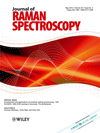
JOURNAL OF RAMAN SPECTROSCOPY
Scope & Guideline
Transforming scientific understanding through Raman innovation.
Introduction
Aims and Scopes
- Raman Spectroscopy Techniques:
The journal extensively covers various Raman spectroscopy techniques, including surface-enhanced Raman spectroscopy (SERS), coherent anti-Stokes Raman scattering (CARS), and micro-Raman spectroscopy, focusing on their development, optimization, and applications. - Interdisciplinary Applications:
Research published in the journal spans multiple disciplines, highlighting the versatility of Raman spectroscopy in fields such as biomedicine, environmental monitoring, art conservation, and material science. - Innovative Methodologies:
The journal promotes innovative methodologies that integrate Raman spectroscopy with other analytical techniques, such as X-ray fluorescence and mass spectrometry, enhancing the analytical capabilities and providing comprehensive insights. - Theoretical and Computational Studies:
There is a significant focus on theoretical and computational approaches that complement experimental findings, particularly in understanding the molecular and structural dynamics observed in Raman spectra. - Cultural Heritage and Archaeology:
The journal showcases applications of Raman spectroscopy in cultural heritage studies, emphasizing non-invasive techniques for analyzing historical artifacts, pigments, and materials.
Trending and Emerging
- Machine Learning and AI Integration:
There is an increasing trend towards the application of machine learning and artificial intelligence in analyzing Raman spectra, enhancing data interpretation and classification in biomedical and material science applications. - Environmental and Forensic Applications:
Research focusing on environmental monitoring and forensic applications of Raman spectroscopy is on the rise, showcasing its effectiveness in detecting pollutants and analyzing crime scene evidence. - Nanotechnology and Plasmonics:
The use of nanotechnology, particularly plasmonic materials, to enhance Raman signals through SERS is a rapidly growing area, reflecting advancements in material science and fabrication techniques. - Biological and Medical Diagnostics:
Emerging themes include the application of Raman spectroscopy in the diagnosis of diseases and monitoring biological processes, highlighting its potential in clinical settings. - Cultural Heritage Preservation:
A notable increase in studies related to the preservation of cultural heritage through non-invasive Raman techniques indicates a growing interest in the intersection of science and history.
Declining or Waning
- Traditional Applications:
There is a noticeable decline in papers focused solely on traditional applications of Raman spectroscopy in classical chemistry, as researchers are increasingly exploring interdisciplinary applications and integrating modern techniques. - Basic Spectroscopic Studies:
Basic studies investigating the fundamental aspects of Raman scattering without direct application have become less frequent, as the field moves towards more applied research with tangible outcomes. - Single-Modal Spectroscopy:
The focus on single-modal Raman spectroscopy studies is decreasing, with a growing preference for multi-modal approaches that combine Raman with other techniques for enhanced analytical power. - Low-Resolution Techniques:
Research involving low-resolution Raman techniques appears to be waning, as advancements in instrumentation have led to a preference for high-resolution and hyperspectral imaging techniques.
Similar Journals
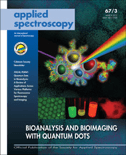
APPLIED SPECTROSCOPY
Empowering Discoveries in Instrumentation and ApplicationsApplied Spectroscopy, published by SAGE Publications Inc, is a leading journal in the field of spectroscopy and instrumentation, with a legacy dating back to 1970. This esteemed journal, recognized within the Q2 category for both Instrumentation and Spectroscopy in 2023, provides critical insights and advancements that cater to a wide audience of researchers, professionals, and students. With its Scopus rankings placing it in the top 20% of publications in its respective fields, Applied Spectroscopy stands out for its rigorous peer-reviewed content that drives innovation in analytical techniques and applications. Though not an open-access publication, readers can access a wealth of research articles, reviews, and experimental findings that enrich the scientific discourse in spectroscopy. With a focus on enhancing the understanding and practical applications of spectroscopy, this journal is an essential resource for anyone engaged in this dynamic and evolving discipline.

ATOMIC SPECTROSCOPY
Elevating Knowledge in Atomic and Molecular Spectroscopy.ATOMIC SPECTROSCOPY is a distinguished journal specializing in the field of spectroscopy and published by ATOMIC SPECTROSCOPY PRESS LTD. With ISSN 0195-5373 and e-ISSN 2708-521X, this journal has been a cornerstone in advancing the discipline since its inception, thriving in its relevant domain for over four decades, covering converged research years from 1980 to 1989 and from 1996 to 2024. Currently holding a Category Quartile of Q2 in Spectroscopy for 2023, ATOMIC SPECTROSCOPY ranks 34th among 76 in its field according to Scopus, placing it in the 55th percentile, thereby affirming its critical role as a resource for researchers, professionals, and students alike. This journal serves as a platform for disseminating innovative research, methodological advancements, and breakthroughs in atomic and molecular spectroscopy, fostering a comprehensive understanding that is essential for progress in analytical chemistry and related disciplines. While it operates under a non-open access model, the journal ensures broad reach and visibility within the academic community. For those passionate about spectroscopy, ATOMIC SPECTROSCOPY remains an invaluable resource for staying updated on the latest developments, contributing to its reputation as a leading journal in the field.
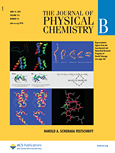
JOURNAL OF PHYSICAL CHEMISTRY B
Transforming Ideas into Breakthroughs in ChemistryJournal of Physical Chemistry B, published by the American Chemical Society, is a leading international platform dedicated to advancing our understanding of physical chemistry and its applications in various interdisciplinary fields. With an impressive 2023 Impact Factor, and categorized in Q1 for Physical and Theoretical Chemistry as well as Surfaces, Coatings and Films, this journal showcases cutting-edge research that contributes significantly to materials science, supporting the innovative development of new materials and technologies. The journal, established in 1997 and converging its years of publication to 2024, maintains rigorous peer-review standards and is accessible to a global audience, enabling the dissemination of pivotal research findings. Moreover, it is renowned for its comprehensive coverage in the realms of materials chemistry and miscellaneous medical applications, making it a vital resource for researchers, professionals, and students alike in their pursuit of excellence in scientific inquiry.
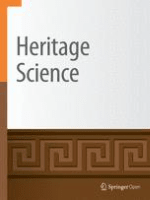
Heritage Science
Leading the Way in Innovative Heritage ResearchHeritage Science is a prestigious open-access journal, published by Springer since 2013, dedicated to the fields of heritage conservation and archaeology. With an ISSN of 2050-7445, it offers a platform for innovative research and critical discussions, encompassing interdisciplinary approaches that bridge the gap between art, science, and technology. The journal proudly ranks in the Q1 category for both Archaeology (arts and humanities) and Conservation, highlighting its influence and reputation within these scholarly realms. Furthermore, its presence in Scopus with impressive percentile rankings—such as #7 in Conservation and #23 in Archaeology (arts and humanities)—asserts its role as a leading voice in heritage studies. The journal's commitment to open access enhances the dissemination of knowledge, making it an essential resource for researchers, professionals, and students engaged in the preservation and interpretation of cultural heritage. Heritage Science continues to set standards in research quality, encouraging contributions that advance the understanding and sustainability of our shared heritage.
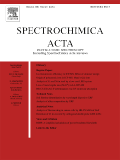
SPECTROCHIMICA ACTA PART B-ATOMIC SPECTROSCOPY
Exploring the Depths of Atomic Interactions and Applications.SPECTROCHIMICA ACTA PART B-ATOMIC SPECTROSCOPY, published by PERGAMON-ELSEVIER SCIENCE LTD, is a leading peer-reviewed journal dedicated to advancing the field of atomic spectroscopy. With a respectable impact within its category—achieving Q2 quartile rankings in Analytical Chemistry, Atomic and Molecular Physics, Instrumentation, and Spectroscopy according to the 2023 metrics—this journal plays a pivotal role in disseminating high-quality research findings. Over its impressive publication history since 1967, the journal has continuously provided a platform for researchers to present innovative methodologies, theoretical advancements, and practical applications related to atomic spectroscopy. The journal is recognized for its rigorous peer-review process and aims to foster scholarly dialogue among professionals and students alike, reinforcing its significance in the scientific community. Although it does not offer open access options, its strong presence in notable databases ensures that the research reaches a broad audience. As a part of the ongoing dialogue in atomic and molecular sciences, SPECTROCHIMICA ACTA PART B is an essential resource for those at the forefront of related research.

SPECTROCHIMICA ACTA PART A-MOLECULAR AND BIOMOLECULAR SPECTROSCOPY
Fostering breakthroughs in the understanding of molecular dynamics.SPECTROCHIMICA ACTA PART A-MOLECULAR AND BIOMOLECULAR SPECTROSCOPY, published by PERGAMON-ELSEVIER SCIENCE LTD, stands as a pivotal resource in the fields of molecular and biomolecular spectroscopy, providing a platform for researchers to disseminate significant findings from both analytical chemistry and molecular physics. With an impactful presence reflected in its Q2 rankings across several categories, including Analytical Chemistry and Spectroscopy, this journal aims to foster advancements in the understanding of molecular interactions through innovative spectroscopic techniques and methodologies. Despite not providing open access, its authoritative articles are crucial for professionals seeking to stay at the forefront of research and development in the discipline. The journal also showcases an impressive pedigree, ranked in the top tiers of Scopus indicators, including high percentiles in both Chemistry and Physics domains. With coverage expanding from 1995 to 2025, SPECTROCHIMICA ACTA PART A remains an essential reading for anyone dedicated to the evolution of spectroscopic science.
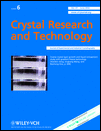
CRYSTAL RESEARCH AND TECHNOLOGY
Transforming Theoretical Insights into Technological AdvancesCRYSTAL RESEARCH AND TECHNOLOGY, published by WILEY-V C H VERLAG GMBH, is a distinguished journal in the fields of Chemistry, Condensed Matter Physics, and Materials Science, with over five decades of continuous publication from 1966 to 2024. With its ISSN 0232-1300 and E-ISSN 1521-4079, the journal serves as a crucial platform for disseminating significant research findings, theoretical advances, and technological innovations related to crystal growth, structure, and properties. Holding a Category Quartile ranking of Q3 in the 2023 assessments across its disciplines, CRYSTAL RESEARCH AND TECHNOLOGY is recognized for its contribution to the scientific community, making it an essential resource for researchers, professionals, and students alike. While this journal is not open access, its robust publishing framework ensures that high-quality peer-reviewed articles remain accessible to a global audience. The importance of this journal lies in its commitment to advancing knowledge and fostering collaborations in crystallography and related fields.

PHYSICS AND CHEMISTRY OF MINERALS
Advancing Insights into Mineral InteractionsPHYSICS AND CHEMISTRY OF MINERALS, published by SPRINGER, is a premier journal dedicated to advancing the understanding of the physical and chemical properties of minerals, their interactions, and their significance in various geological processes. With an ISSN of 0342-1791 and an E-ISSN of 1432-2021, this journal serves as a vital resource for researchers and professionals in geochemistry and petrology, as well as materials science. Reflecting the journal's commitment to quality scholarship, it has achieved Q3 rankings in both Geochemistry and Petrology, and Materials Science (miscellaneous) categories. Established in 1977 and continuing through 2024, the journal has consistently provided a platform for high-impact research, fostering collaboration and innovation in the field. Located in Germany and reaching a global audience, PHYSICS AND CHEMISTRY OF MINERALS is instrumental for students, academics, and industry experts looking to stay at the forefront of mineral research and applications.

OPTICS AND SPECTROSCOPY
Illuminating the Future of Light-Matter InteractionsOptics and Spectroscopy is a pivotal peer-reviewed journal published by Pleiades Publishing Inc, focusing on the intricate fields of atomic and molecular physics, as well as optics. Established in 1972, and enjoying a legacy of convergence periods that reinforce its commitment to the evolving landscape of these scientific domains, the journal aims to disseminate high-quality research that advances our understanding of light-matter interactions, electronic materials, and spectroscopic techniques. Despite its current Q4 categorization in both the Atomic and Molecular Physics and Electronic, Optical and Magnetic Materials fields, with corresponding Scopus rankings reflecting its developing influence, the journal remains a valuable resource for researchers and professionals seeking to publish their findings, explore new methodologies, and connect with a community dedicated to innovation in optics. Although there is currently no open access option, the journal's expansive readership and its stability in publication over the decades make it an important platform for both established and emerging researchers in the field.

Progress in Superconductivity and Cryogenics
Illuminating the Path of Cryogenic Research and InnovationProgress in Superconductivity and Cryogenics is a distinguished academic journal published by the Korea Institute of Applied Superconductivity & Cryogenics, dedicated to advancing the field of superconductivity and cryogenic technologies. Since its inception in 2009, this journal has served as a pivotal platform for researchers and practitioners, promoting the dissemination of innovative findings and methodologies. Although currently positioned in Q4 quartiles in both Electrical and Electronic Engineering and Electronic, Optical and Magnetic Materials, the journal continually strives for excellence, offering insights that are essential for understanding the complexities of superconducting materials and their applications. While currently not an open-access journal, it provides invaluable research to the global scientific community. The journal's address is located in Changwon, South Korea, and aims to bridge the gap between theoretical research and practical implementation, making it a crucial resource for those engaged in the vibrant study of superconductivity.